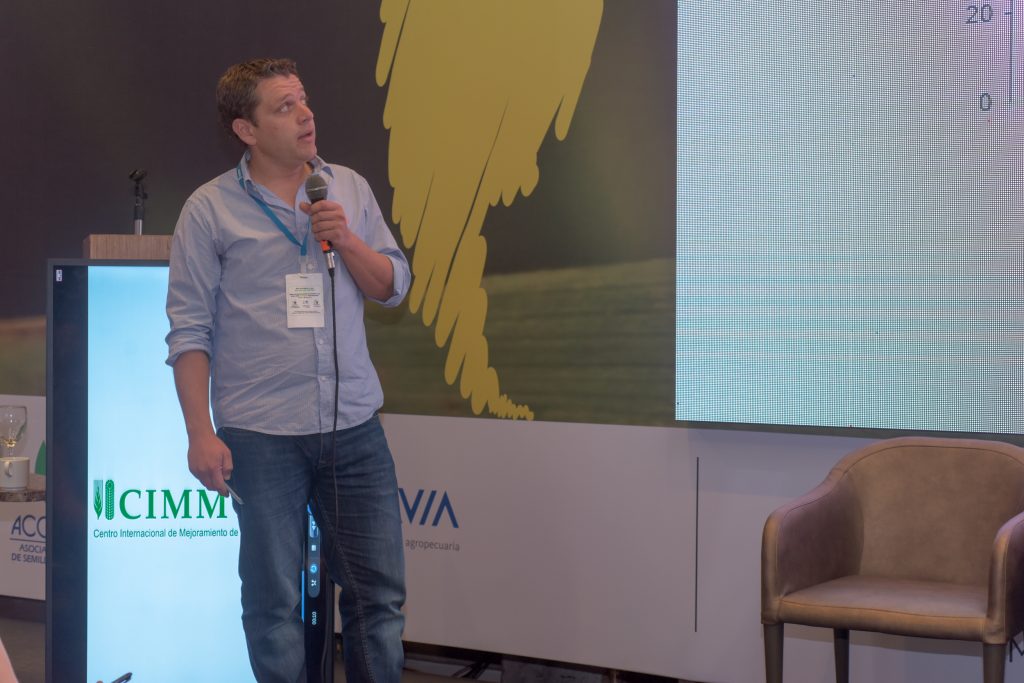Young innovator Lucio Reinoso is helping farmers to maximize maize production while caring for the environment
By Leslie Dominguez and Jennifer Johnson
Lucio Reinoso is an agronomist with a master’s degree in agricultural sciences from the National Southern University, Argentina. Lucio and his team at the National University of Rio Negro and the INTA Lower Valley Experimental Station developed a new seeder that allows farmers to sow their maize using the same furrow from the year before and leaving behind crop residue on the surface, helping them to implement conservation agriculture practices and minimize impacts on the environment. He was recently awarded the MAIZE Youth Innovators Award 2019 – Latin America in the category of researcher for his involvement in this work.
The awards, an initiative of the CGIAR Research Program on Maize (MAIZE), seek to recognize the contributions of young women and men who are implementing innovations in Latin American maize-based agri-food systems. This is the third instalment of the awards, following Asia in October 2018 and Africa in May 2019. The awards ceremony took place at the 23rd Latin American Maize Reunion in Monteria, Colombia on October 9, 2019.

Q: What inspired you to work in agriculture?
I have always been interested in agriculture because I come from a family involved in farming and livestock, and I think that is what led me to pursue a career in agronomy.
After graduating, I moved to Rio Negro Province in Patagonia, Argentina, and I noticed that the production systems are very different from what I knew as they work with irrigation throughout the year. Irrigation allows them to cultivate many things that we could not grow in my region, so I started working and testing my research with maize, which is the crop that, at least in Argentina, adapts very well to different conditions.
Q: What inspired you to develop this innovation?
As a team, we developed a seeder that allows farmers to sow their maize on the furrow from the previous year. The first year the soil is prepared, the furrow is made, it is irrigated and once the maize is harvested, the second year the maize is sown again on the same furrow with the residue that remained, in other words, we work with a zero tillage system.
This innovation has numerous benefits: it improves the distribution of irrigation water in the field by improving the time it takes for water to be absorbed by the soil. It also makes irrigation more efficient, by ensuring that the water filters towards the roots rather than going too deep for the plants to use. It also saves gas as you don’t have to plow every year, reducing carbon emissions from tractors. Keeping the soil covered with residue reduces direct evaporation of water from the soil and prevents erosion, in addition to improving the quantity of macro and mesofauna in the soil such as worms. All of these techniques help us to mitigate climate change by capturing carbon through residue management. At the same time, we are able to achieve yields just as high as through conventional methods, all while protecting the environment.
Q: How does it feel to be a winner of the MAIZE Youth Innovators Awards?
To be considered one of the winners of the MAIZE Youth Innovators Awards in Latin America for seeking to make a positive impact on small farmers is a very important recognition and a great satisfaction. I really appreciate it and I think it will help me to network with scientists and researchers from CIMMYT and other institutions to collaborate.
The MAIZE Youth Innovators Awards are a window to reach many places, because knowledge of the seeder could have just stayed in Patagonia and now, through MAIZE and CIMMYT giving me the opportunity to present my research at this conference, more people can see it and could adapt it depending on their necessities for different production systems.

Q: What are your hopes for the future?
In the region where I am working, Patagonia, maize is being cultivated under irrigation and rotation and the farmers are adopting hybrid seeds, mechanized sowing and the seeder I made with my team. That is why my future expectation is to continue training. I want to complete a PhD related to maize production systems and productive simulation models. I think there is a varietal limitation that is holding us back in the region, specifically in the irrigated valleys of northern Patagonia, which is why I would like to be able to develop adapted materials with high yield potential under irrigation where the climatic, solar radiation, temperature and weather conditions are suitable for better performance.
Q: What advice do you have for other young people interested in agriculture?
In the coming years, we will be seeing an ‘agriculture 4.0’ in which electronics and technology will be even more advanced. Currently, we have satellite images, we analyze the emission spectrum of the crop, we have agronomic simulation models, among other things, which shows that farming and technology can work together. Incorporating technology requires trained professionals so if you are interested in agriculture, you should start preparing yourself to take part.
On the other hand, engaging in research is also a good thing because good results can allow you to have a positive impact on farmers.
Food is the basis of society and there is always work in the area because of its extensiveness. Here in Argentina, we eat at least four times a day and behind those daily meals, there is an agronomist directing the farmer’s tasks, so it is important to have people trained to be able to continue to supply the food demand of the world.

2019 MAIZE Youth Innovators Awards, 2019 MAIZE Youth Innovators Awards Latin America, Argentina, conservation agriculture, Maize, MYIA 2019, MYIA 2019 Latin America, zero-till
